
14 minute read
Priorities for public lands
Representing You in D.C.
PLC Sets 2021 priorities to tackle issues in Washington and beyond
Advertisement
by Public Lands Council Executive Director Kaitlynn Clover
The dawning of each new year brings the promise of a fresh start, of better days ahead. As we began 2020, many of us were looking forward to a year full of progress: the Public Lands Council (PLC) had set goals like modernizing the Endangered Species Act (ESA), making changes to federal grazing regulations to finally lift the harmful realities of “Range Reform of ‘94” and taking intentional steps to improve ranchers’ rightful role in land and resource management.
The year started off well: the Trump administration opened the scoping process to revise Bureau of Land Management (BLM) grazing regulations, the White House started the process to revise National Environmental Policy Act (NEPA) guidance and all the agencies had a full agenda for the last year of the Trump term. As the brand new executive irector, I was thrilled to join PLC and get straight to work.
COVID-19 hit the country, and that ambitious agenda, with a force that can only be described as immense. Delays hit every portion of the public lands rancher’s life; from your ability to make your routine trips to town to your ability to have confidence there would be processing capacity for your beef or lamb, the impact of COVID-19 was undeniable. It delayed the regulatory process, too. While the BLM grazing regulations process got off to a promising start, the agency soon was bogged down in personnel and process delays that left us without any tangible progress as the clocked chimed midnight on Jan. 1, 2021. The Forest Service (USFS) handbook and directives changes were similarly delayed, but the agency was able to issue proposed changes at the 11th hour, even though the opportunity for public comment would fall in the early days of the Biden administration.
Despite the immense challenge, the Trump administration made significant progress in other areas. Before the end of 2020, we saw the U.S. Fish and Wildlife Service (USFWS) federally delist the gray wolf rangewide. The USFWS also finalized two additional ESA rules, which clarified the agency’s ability to designate critical habitat and allow ranchers to request that allotments or portions of allotments be excluded from critical habitat designations. The Environmental Protection Agency (EPA) finalized the “Waters of the United States” replacement rule and the White House finalized government-wide guidance telling agencies that NEPA should be a tool for analysis, not paralysis.
As we enter 2021 with a new administration and a new Congress, many of the issues we faced in 2020 linger. COVID-19 response is ongoing. Resource challenges like poor federal horse and burro management, rampant spread of invasive species, and the threat of catastrophic wildfire also remain. This year is a prime example that while all
...CONTINUED ON PAGE 52
UNMATCHED PERFORMANCE Shandar Angus Ranch

Lazy JB Edge

GCC Money Earned





Conley Express 7211

Jindra Acclaim
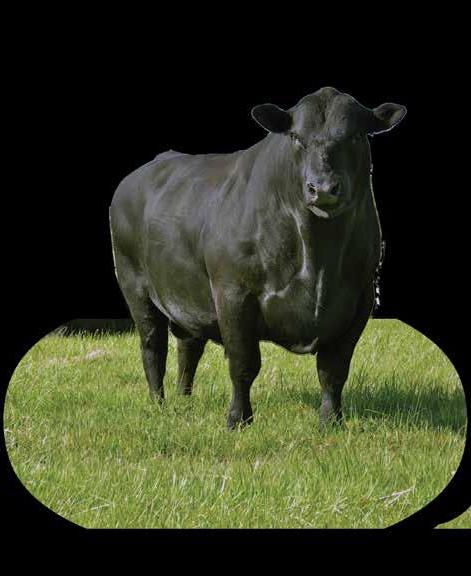

Selling 25 Bulls This Year!
Mos y available by private treaty at the ranch!
Feb 13 Gem State Classic - Twin Falls, ID
Sept ‘21 Royal Blood Online Sale - Online
Nov 13 Rocky Mtn Angus - Ogden, UT Dec 1 UT Ca lemen’s Classic - Sa Lake, UT Call Today - 801-368-8314 or 801-592-7279 Introducing our newest herd sire!Dal Porto SHOWDOWN
EXAR Classen x Sandy 3040 Full sibling to the $160,000 L y JB Edge!
Thank You to Our Recent Buyers at the Utah Ca lemen’s Classic!
Kyle Tanner • Mike Smith • Jim Nelson • and all those who bid on our bulls!
S R
Supreme Champion Bull! Purchased by Ryan Creer, Spanish Fork, UT
ANGUS • SIMANGUS
3532 W 9600 S • Payson, UT 84651 Morgan 801.368.8314 • Landon 801.592.7279 landoman7v@hotmail.com
of the context around PLC’s priorities may change, the basic needs of public lands ranchers stay the same: healthy ecosystems, a functional and fair federal system, and a healthy environment in which to sell our product.
The transition to a Biden administration and a Democrat-held Congress changes the political climate in Washington, D.C. On the first day of his term, President Biden issued a “freeze” on many regulations from the Trump administration and initiated agency review of hundreds more.
New members of Congress jockeyed for positions on key committees to give voice to their constituents on key issues. No matter the committee, however, we know that all policy will face a singular question: “What does this mean for the climate?”
For the next four years, climate will be at the center of every policy conversation. The good news is that public lands ranchers have the best story to tell: the lands you graze are integral for carbon storage. They provide critical habitat for wildlife and forage of all kinds, including endangered species. Your cattle and sheep are the first line of defense against fuel loading that contributes to catastrophic wildfire, and are the first responders when lands scarred by fire are at 2021 UTAH ANGUS.pdf 1 1/13/21 10:45 PM risk of being overtaken by invasive annuals.
While all of PLC’s priority issues – making ESA and other regulations workable, reducing herds of horses and burros managed by BLM, reducing the risk of catastrophic wildfire, and defending ranching’s cultural heritage – stay the same, the questions asked about each of those subjects changes.
We remain committed to working with Congress to secure additional funding for the BLM to gather, remove, and apply fertility treatments to horses and burros under their management. We continue to tell the good news story of public lands ranching, and demonstrate what a nimble, flexible tool grazing is to achieve land management objectives. We continue to work with partners like the USFWS, Ducks Unlimited, Safari Club International and the National Cattlemen’s Beef Association, who joined us in signing a memorandum of understanding outlining our shared commitment to active management of landscapes across the country.
PLC’s mission is this: to support and maintain livestock grazing on public lands by advocating for and educating decision makers of the many values livestock grazing contributes to our natural resources and to the public.
From drought to litigation, 2021 is shaping up to be another one for the books. PLC is ready for the fight. We’ve prepared by strengthening relationships with groups across the spectrum, developing clear policy positions and giving voice to producers so your story reverberates through the halls of Congress.
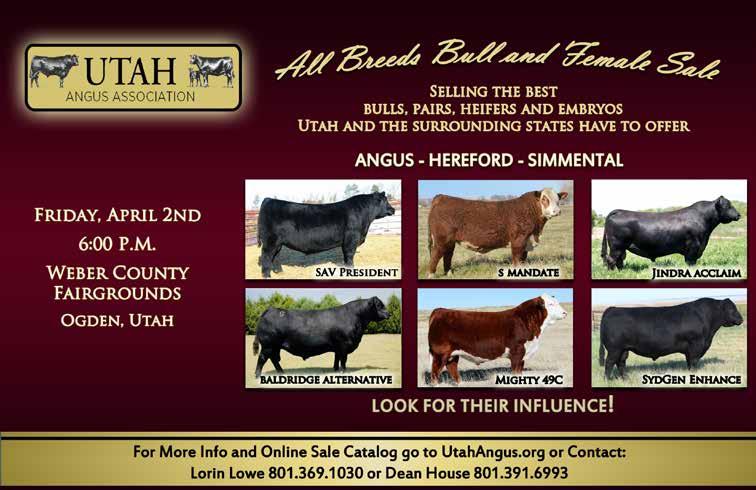
Effective in fall of 2020, the state veterinarian’s office released a re-written the Trichomoniasis rule found in R5821 to reduce confusion and, hopefully, better protect the Utah cattle industry from this devastating disease. The rule changes should be open for public comment in November. A summary of the updated rule is below:
Sampling and Testing
· Samples must be obtained by a certified veterinarian.
Technicians are not allowed to collect trich samples. · Samples must be submitted to an approved laboratory in a transfer tube instead of a pouch. This will allow a more rapid turn-around time on testing at UVDL. · In most cases, samples may be pooled. Herds at high risk or under investigation for trich may be required to have individual bull tests. · Tested bulls must be tagged with an RFID tag and an official trich tag. Resident Cattle · All resident bulls 12 months of age and older, including bison, must be tested annually between October 1 and May 15. Resident dairy bulls that are confined (no possibility of escape) are exempt from the testing requirement unless they are being offered for sale or have had exposure to female cattle from another herd. · Bulls with continuous exposure to female cattle must be tested by January 1. · All bulls being offered for sale, lease, or loan must be tested prior to sale/lease/ loan. The owner of these bulls must declare to a brand inspector whether the bull was exposed to female cattle after it was tested. · Untested bulls or bulls that have had exposure to female cattle after testing may only be sold for slaughter or to a qualified feedlot. · Female cattle over 12 months old may only be sold for slaughter or feeding unless the owner declares to the brand inspector that the herd is not a known positive trichomoniasis herd. · Untested bulls must be kept separate from female cattle at auctions.
Imported Cattle
· All bulls 12 months of age and older, including bison and dairy bulls, must be tested prior to entry. Bulls that are exposed to female cattle after testing must be retested prior to entry. Exemptions include: bulls going to slaughter, a qualified feedlot, or exhibition where they return immediately to the state of origin with no grazing
or exposure to female cattle. · Health certificates for female cattle must have the statement “These cattle have not been commingled with bulls of positive or unknown trichomoniasis status.” · Female cattle from positive herds can only enter Utah if they are 120 days pregnant, known virgin heifers, going to slaughter or a qualified feedlot, or have had 120 days isolation from any bulls. · Imported bulls may be tagged with a Utah trich tag by a veterinarian if accompanied by proof of testing.
Positive Herds
· Positive herds will be quarantined and placed under a
Trichomoniasis Herd Plan, which sets the requirements for the herd to be released from quarantine. The State
Veterinarian may require additional testing of bulls, pregnancy testing of females, or segregation of bulls and female cattle. · The owner of a positive herd must notify the administrator of their common grazing allotment and all neighboring cattlemen within 10 days. The owner also needs to provide a list of neighboring cattlemen to the
State Veterinarian’s office within 10 days. · Positive bulls must be branded with a V brand on the tailhead and sold to slaughter or a feedlot within 14 days (unless it is under a drug withdrawal period). Positive bulls must be kept separate from female cattle prior to sale. · Other bulls in the herd must be retested prior to exposure to female cattle. · Movement of any cattle, including females, from a positive herd must be documented on a “Movement of cattle from a Trichomoniasis-Positive Herd” form, and the form must be sent to the State Veterinarian’s office within 72 hours of movement. Cattle moving out of the state must also have a VS 1-27 form. · The owner must provide a list of all sales of non-virgin female cattle since the prior year’s test to the State
Veterinarian’s office. The state veterinarian will attempt to notify the recipients of those cattle.
Citations
· The citation for untested bulls (after May 15 or with exposure to female cattle at any time of the year) remains at $1000.
LOT 45
12:30 P.M. MST ~ AT THE RANCH, BRUNEAU, IDAHO
LOT 24 LOT 46
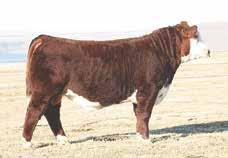


AHA 44122963
C CJC 4264 LAD 0137 ET
CED 5.8 BW 3.9 WW 69 YW 110 MM 31 Awesome look and pedigree in this prospect. REA 0.42 Dark red color with big red eyes. He is a MARB CHB 0.51 167 maternal brother to Belle Heir and with chart topping IMF and CHB values. Genomics say he should be an easier calving sire while still staying in the top 2% of the breed for growth at both weight periods.
LOT 96
AHA 44122903
C 2052 LONG RANGE 0074 ET
CED 4.4 BW 2.6 WW 59 YW 98 MM 32 This Long Range son blends together every- REA 0.39 thing cattlemen are searching for into one com- MARB CHB 0.25 123 plete package. He comes from one of our most popular donors 2052 and has so many of her qualities that made her a standout. Huge bodied with tons of shape and doability. He truly bridges the gap between good cattle that have calving ease, performance, maternal traits and carcass.
LOT 40
AHA 44122964
C 1311 LONG RANGE 0138 ET
CED 1.7 BW 2.6 WW 57 YW 95 MM 31 Here is a polled Long Range son out of Miles REA 0.65 McKee’s full sister 1311. If you are looking for MARB CHB 0.06 118 an all around sire with tremendous phenotype and look this is a great place to land. His mother is one of the best donors we have produced and her presence in pedigrees is a must. She is close of having one million dollars of progeny sales with numerous daughters being flushed.
LOT 94
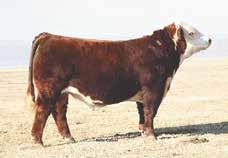



AHA 44077440
C 1311 MR CANADA 9324 ET
CED 7.2 BW 2.4 WW 61 YW 90 MM 38 Mr. Canada son out of a full sister to Miles REA 0.79 McKee. Maternal brother to Double Your MARB CHB -0.01 104 Miles, Special Edition and numerous donors like 6018. Lots of calving ease with as much pigment and maternal excellence as you can build in one.
LOT 21
AHA 44122948
C 1311 4013 INNISFAIL 0121 ET
CED -0.6 BW 4.0 WW 68 YW 105 MM 30 This young herd sire will be found by many top REA 0.54 cattlemen this spring. He is a full brother to the MARB CHB 0.42 160 lot 11 female from the fall sale that so many were trying to own. Performance and weight with a 160 CHB in the top 1% of the breed but still has the maternal strength.
LOT 141
AHA 44077469
C BAR1 BAILEE VALOR 9354
CED -0.6 BW 3.4 WW 66 YW 109 MM 22 Exciting young sire with as much look and REA 0.77 quality as you can find. He is bred for standout MARB CHB 0.14 154 phenotype but has a great EPD profile to go along with it. Huge growth numbers with excellent carcass traits place him in the top 2% for CHB.
LOT 158
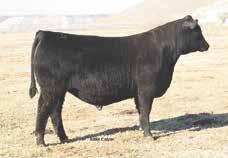
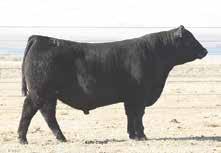

AHA 44122894
C BELLE HEIR 0065
CED 9.5 BW 0.3 WW 60 YW 88 MM 36 This young sire could prove to be very useful REA 0.53 when breeding replacement females this spring. MARB CHB 0.35 145 He is out of a first calf heifer that made it straight to the donor pen. Use this one for udder quality and calving ease but also his carcass values and look makes him a big time prospect.
AAA 19778381
CCC BANKROLL 0007
BW 0.2 WW 70 YW 123 SC .83 CEM 12 MILK 35 $W 87 Big time herd sire prospect that is out of a first $F $G 94 57 calf heifer. He has been a standout in the group $B $C 151 277 because of his extra muscle and rib shape. Balanced EPD profile with enhanced REA and $W values. He has the phenotype of a western ranchers kind with a set of numbers that are hard to find a hole in.
Guy, Sherry and Katie Colyer, 208.845.2313 Kyle, 208.250.3924 • GUY cell: 208.599.0340 email: guy@hereford.com • FAX: 208.845.2314
AAA 19778409
CCC CASINO BOMBER 0043
BW 1.1 WW 91 YW 145 SC 0.59 CEM 8 MILK 13 $W 81 This Bomber son has a great look with an explo- $F $G 92 52 sive growth curve that places him among the $B $C 144 249 breeds elite. He is in the top 1% WW and top 2% for YW. His mother has been a top producer posting WWR of 103 and YWR of 106.
~ OFFERING 250 BULLS & 45 FEMALES ~
Horned Hereford | Polled Hereford | Angus
Two-Year-Olds, Senior Yearlings and Yearlings









